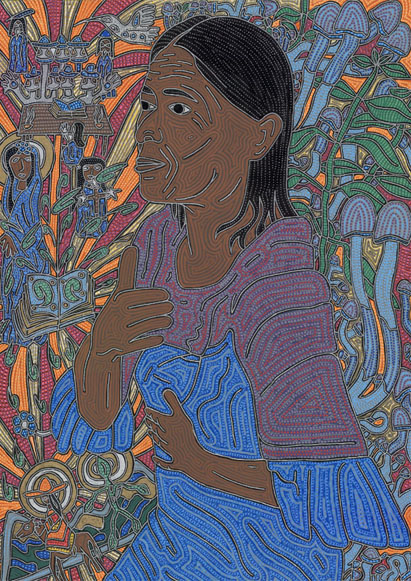As an artist whose work deals with vision and the experience of myth, the nature of these perennial themes in human culture is of principal importance to me, as is the nature of the art that I do: Visionary Art, a complex and multi-faceted artform. At heart, for me, it is the inner and outer quest to uncover ancient and future sacred images that reveal the deepest wordless essences of what it means to be alive in this cosmos as a human being. The visionary image is transpersonal, and transcultural, unhinged from the personal and from local time, place or culture into realms of myth, of sacred journeys, of dreams and imaginal flights of fancy, shamanic and entheogenic visions, and of half-forgotten sacred vistas shimmering within the Underworlds of our Human Souls. And for all of this to be rendered using techniques that speak of craft, lineage and ancestral lifeways.
|
In one of my first posts on this blog, I mentioned that one of my writing projects, entitled 'On Vision', would eventually be featured here on 'Archaic Visions'. In the ensuing period, the remit of this writing project has rather expanded, and thus is now called 'On Vision and Being Human' to reflect the wider purview - Darwinist, neurological, cognitive - that I am taking in my quest to come to a new understanding of the nature of visionary experience. As I write, this essay stands at some 45,000 words with a few more sections still to write, and as such, the serialisation here will likely last a long time! Eventually, an illustrated book is planned... For now, however, here is the introduction to the thesis, which I hope will whet your appetite for further reading!
As an artist whose work deals with vision and the experience of myth, the nature of these perennial themes in human culture is of principal importance to me, as is the nature of the art that I do: Visionary Art, a complex and multi-faceted artform. At heart, for me, it is the inner and outer quest to uncover ancient and future sacred images that reveal the deepest wordless essences of what it means to be alive in this cosmos as a human being. The visionary image is transpersonal, and transcultural, unhinged from the personal and from local time, place or culture into realms of myth, of sacred journeys, of dreams and imaginal flights of fancy, shamanic and entheogenic visions, and of half-forgotten sacred vistas shimmering within the Underworlds of our Human Souls. And for all of this to be rendered using techniques that speak of craft, lineage and ancestral lifeways.
5 Comments
Some ten years ago, my path as an artist and vision-seeker took a profoundly interesting turn when I began to work with the Mazatec entheogenic plant salvia divinorum, known in Mazatec as xca maria pastora 'the leaves of Mary the Shepherdess'. In seeking to more deeply contact the salvic world disclosed by the visions I was experiencing, I began to become curious about the Mazatec people and their language, and while doing so, discovered that when anthropologists speak about indigenous Mazatec shamanism, all is not quite as it seems. The translation of many Mazatec concepts into English in some of the academic literature seems at least partly ideologically-motivated, and involves a considerable loss of the indigenous worldview, even when other, better English words are available for a given translation. This tour through various Mesoamerican 'shamanic' words seeks to counter that loss, which has passed into the wider visionary culture. The English word 'wise' is a curious term, often synonymous with 'learned' and stative in intent: a wise person is not wise through action, but through having known, the knowledge now functioning as a kind of attribute of the person so described. Cognate with Dutch wijs 'wise' and German wissen 'to know (a fact or situation)', it has its ultimate origin in Proto-Indo-European *weyd- 'see, know', and thus its grounding in this notion of 'having seen, having known' is rather ancient.
Japanese however has no such concept in its lexicon: there are words which are somewhat similar, such as kashikoi 'clever, smart, wise, intelligent', umai 'skillful, clever, expert' and in Classical Japanese of the Heian Period, satoshiki 'clever, perceptive', but these words do not relate to knowing or having seen. Rather they relate lexically to, respectively, 'having grace or humility', 'being generally good or excellent' and 'having realised in a meditative manner' (compare satori, the Japanese translation for 'enlightenment'). Japanese is here sufficiently different from the Indo-European cultural sphere for an appreciation of this difference to be evident. |
ARCHAIC VISIONS
|




 RSS Feed
RSS Feed






